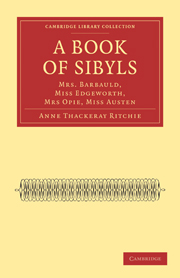MRS. OPIE [1769–1853]
Published online by Cambridge University Press: 01 March 2011
Summary
‘Your gentleness shall force more than your force move us to gentleness.’
–As You Like ItIt is not very long since some articles appeared in the ‘Cornhill Magazine’ which were begun under the influence of certain ancient bookshelves with so pleasant a flavour of the old world that it seemed at the time as if yesterday not to-day was the all-important hour, and one gladly submitted to the subtle charm of the past—its silent veils, its quiet incantations of dust and healing cobweb. The phase is but a passing one with most of us, and we must soon feel that to dwell at length upon each one of the pretty old fancies and folios of the writers and explorers who were born towards the end of the last century would be an impossible affectation; and yet a postscript seems wanting to the sketches which have already appeared of Mrs. Barbauld and Miss Edgeworth, and the names of their contemporaries should not be quite passed over.
In a hundred charming types and prints and portraits we recognise the well-known names as they used to appear in the garb of life. Grand ladies in broad loops and feathers, or graceful and charming as nymphs in muslin folds, with hanging clouds of hair; or again, in modest coiffes such as dear Jane Austen loved and wore even in her youth. Hannah More only took to coiffes and wimples in later life; in early days she was fond of splendour, and, as we read, had herself painted in emerald earrings.
- Type
- Chapter
- Information
- A Book of SibylsMrs. Barbauld, Miss Edgeworth, Mrs Opie, Miss Austen, pp. 149 - 196Publisher: Cambridge University PressPrint publication year: 2010First published in: 1883



